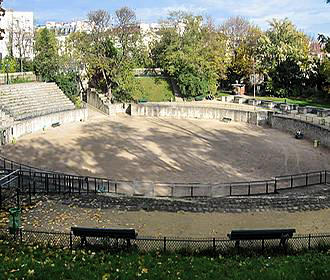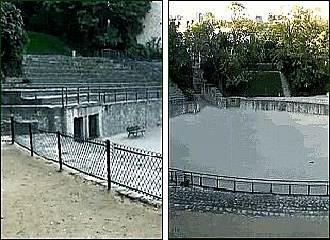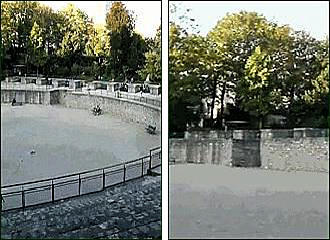Arenes de Lutece Roman Arena in Paris
Even though most people realise that the capital city of France is famous for its monuments, museums and its landmarks, there are many that do not realise that the history of Paris goes way back to before the city even had this name.
Before the capital city of France was called Paris it was known as Lutece or Lutetia and was occupied by the Romans, however, it is only within the 5th Arrondissement of Paris that you will still be able to find ruins and remnants of their existence.
Gallo-Roman times
It was a prosperous town in the Gallo-Roman times that contained a large arena and amphitheatre called the Arenes de Lutece along with the thermal baths known as the Thermes de Cluny.
Located on the Montagne Sainte-Genevieve the Arenes de Lutece is thought to have been built towards the end of the first century AD and is also thought to have been the largest structure of its kind that was constructed by the Romans, as it different from many of the other amphitheatres still in existence.
This arena in Paris had a sunken arena that was surrounded by the wall of a podium, which was about 2.5 metre high, plus it had a stage that was approximately 41 metres long, and historians believe that over 15,000 people could be accommodated to see a performance on the tiered stands and upper bleachers.
There were also five cubby holes that were situated beneath the lower stands and it is believed that three of these would have been used to hold wild animals, as they open up directly on to the arena floor itself.
However, during the barbaric invasions some of this arena was destroyed, as some of the simple stonework of the amphitheatre was used by the Gallo-Romans to reinforce the defences around the Ile de la Cite island in the middle of the River Seine, which is where they had taken refuge.
Not much is known for the next few centuries, apart from the fact that apparently Philippe Auguste filled some of the Arenes de Lutece in, following the construction of defence walls in the 13th century.
Theodore Vaquer, who was an architect but worked on excavations and archaeology in the city of Paris becoming an inspector for the history of Paris, re-discovered the arena during the building of the Rue Monge between in 1869.
And then the famous author Victor Hugo, along with some other intellectuals, decided to save this archaeological site and set up the preservation committee called la Societe des Amis des Arenes.
Around a third of the Arenes de Lutece arena were uncovered in around 1885 and then the city of Paris dedicated funds to restoring the arena and decided to make it a public square, which was opened in 1896.
Further excavations continued up until just before the end of World War I and renovations were also implemented, which to some extent is a shame, because the bleachers, or tiered stone seating, are not original, but it does provide the visitor with a better feel for what this arena and amphitheatre was like in Roman times when Paris was known as Lutetia.
However, due to the buildings that line Rue Monge, there is still a portion of the original arena opposite the stage, which is now lost forever. But standing in the centre of the arena you can still observe significant remnants of the stage and its nine niches, as well as the grilled cages in the walls for the animals that would have been used in the gladiator tournaments.
Accessing the Arenes de Lutece today
Located in the 5th Arrondissement of Paris, it is here that you will be able to discover the Arenes de Lutece, along with the only other remnants left from the Gallo-Roman era, which include the Thermes de Cluny thermal baths of the Musee de Cluny that is also known as the Musee National du Moyen Age.
There are actually three different entrances to get to the Arenes de Lutece arena and amphitheatre and the first is an open corridor accessible from Rue de Navarre through a gate and the second is through the Square Capitan from its entrance at 10 Rue des Arenes.
However, the easiest way to find this hidden treasure and incredible landmark in Paris is via a passageway through the building at 47 Rue Monge. Now, when you first see the entrance, you would not actually expect it to go into an area that is open to the general public.
Yet there are some telltale signs to look out for including a stone plinth above the entrance that says Arenes de Lutice and the dates when parts of this Roman arena were re-discovered, plus there is a cement emblem that is of a gladiators helmet above this plaque as well.
Also, next to the entrance on the wall there is a Histoire de Paris sign, which is almost shaped like a shield that you will often see dotted all over the city of Paris, and this provides a brief description of the archaeological site.
This little known and tranquil haven of peace is open every day of the year from 9am through to 5.30pm in winter and from 9am through to 9.30pm in summer months and is a great place to visit on a nice warm day where you can relax away from the hustle and bustle. And in fact, there are lots places to sit with a book or enjoy a family picnic and you will often see people playing the old game of petanque or French boules, children playing football, etc.
So when it comes to getting here via public transport in Paris, you will find that the nearest Metro station is called the Cardinal Lemoine stop serving Line 10, which is the closest to the Rue Monge entrance.
The Bus Line 47 along with the Noctilien Night Bus Service via Lines N15 and N22 also stop on the Rue Monge, however to the east of the Arenes de Lutece, the Metro station called the Jussieu stop serves Lines 7 and 10, plus the Bus Lines 67 and 89 are located by the Metro on the Rue Linne.
However, if you are travelling on the RER trains, then the nearest train station is past the Jardin des Plantes in a south easterly direction, and called the Gare d'Austerlitz, this serves the TER and Intercities trains along with the RER C Line, plus it is a Metro station for Lines 5 and 10.
Address details
Arenes de Lutece, 47 Rue Monge, 75005, Paris, Ile de France, France


